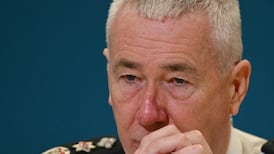It is rare for the Garda to make an official statement on the links between the IRA and Sinn Féin. So when Garda Commissioner Drew Harris said on Friday it was the opinion of the force that one still exerts control over the other, it predictably made political waves.
Harris’s comments were simple and brief but they have been interpreted in vastly different ways by Sinn Féin’s opponents and supporters. Some have accused him of interference in the process of government formation, others of simply reheating out-of-date intelligence.
Was it a planned announcement?
Not exactly. Harris was attending a passing-out parade at Templemore for graduating gardaí and, as is traditional, made himself available to the media for questions afterwards. That day The Irish Times had reported the PSNI still believes the IRA Provisional Army Council oversees both the IRA and Sinn Féin. Harris was asked if the Garda agreed with this view and replied that it did.
Although many questioned the timing of his views, they do not differ from those expressed by senior individual gardaí in recent years.
What exactly does the latest assessment say?
The PSNI said its analysis of the link between the IRA and Sinn Féin remains the same as that laid out in a joint assessment conducted with MI5 in 2015. In that report, a number of definitive statements were made about the IRA including that its structures remained “in a much reduced form”, that it is not actively recruiting and that its leadership is committed to achieving a united Ireland through peaceful means.
Crucially, it stated it was the view of IRA members that the army council oversees both the IRA and Sinn Féin “with an overarching strategy”. This strategy has “a wholly political focus”, it added.
What did they base this view on?
The report lists a wide range of intelligence-gathering methods used to form the conclusions including surveillance, eavesdropping, covert intelligence agents and open source information such as internet postings.
It also warns that, while it was confident in its assessment, the conclusions should not be interpreted as evidence which could be used in a criminal court.
Ironically, given its current significance, the report was first commissioned to resolve a political crisis in Stormont and reassure unionists that IRA violence was a thing of the past.
Harris was second in command of the PSNI at the time. So wasn’t he basically just agreeing with himself on Friday?
No. It is clear from the comments that Harris was expressing the view of Garda intelligence, not giving his own assessment. The Garda, through the Special Detective Unit and the secretive National Surveillance Unit, continue to actively assess the capabilities of paramilitary groups north and south of the border.
Although most of the focus these days is on dissident groups who remain committed to violence, some resources are still assigned to monitoring Provisional IRA members.
Is there any other evidence linking Sinn Féin to the IRA army council?
Accusations that Sinn Féin is controlled by the army council surfaced again recently when documents were released during Northern Ireland’s “cash-for-ash” inquiry showing one of its ministers in the Northern Executive sought approval for decisions from figures who had been members of the IRA.
The inquiry heard the Sinn Féin minister for finance Máirtín Ó Muilleoir consulted a number of former IRA members and senior republican Ted Howell, a long-standing confidante of former Sinn Féin president Gerry Adams.
How does the 2015 report compare with other assessments?
There have been many official reports on the IRA and its army council since decommissioning and they have not always agreed with each other.
In 2008, the Independent Monitoring Commission said the army council "by deliberate choice is no longer operational or functional".
It added: “This situation has been brought about by a conscious decision to let it fall into disuse rather than through any other mechanism.”
The following year, the commission seemed to slightly revise this wording to suggest the dissolution of the army council was an ongoing rather than completed process.
In 2015, in a rare official statement on the topic, the office of then Garda commissioner Nóirin O’Sullivan stated the Garda had no information or intelligence that “the Provisional IRA still maintains its military structure”.
In 2005, the Independent Monitoring Commission on Decommissioning said, based on Irish and UK government estimates, the IRA had disposed of all its weapons. However several later reports said the group continued to hold some arms.
These contradictions aside, there is one overarching conclusion reached by every report published in the last 15 years – the IRA’s military campaign is a thing of the past and is highly unlikely to return.
What does Sinn Féin say?
“The reality is that we now live in a peaceful dispensation, the war is over, the IRA has gone away and democracy is the order of the day and there’s no dispute around that,” party president Mary Lou McDonald said on Friday.
“I know Drew Harris has said he will work with any party with a democratic mandate and that’s exactly as it should be.”
Other party figures struck a more combative tone over the weekend. "The politicising of the gardaí by Drew Harris is deeply worrying for citizens" said newly elected TD for Mayo Rose Conway-Walsh, who claimed that individual gardaí were "very upset by his actions."










